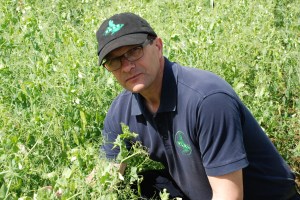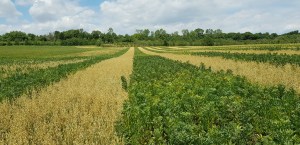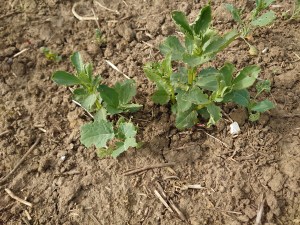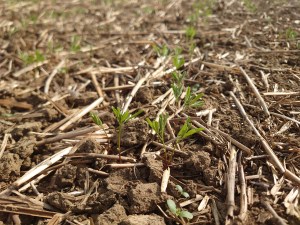After many years of growing and trialling beans in various forms, Andy Howard shares with CPM his triumphs and his lessons learnt when it comes to including pulses in the rotation.
“We found a £200/ha benefit from growing beans and oats together, compared with growing them alone.”
By Charlotte Cunningham
Like many farmers, it has been a challenging spring for Kent grower Andy Howard. The prolonged cold and wet spell has delayed drilling significantly, putting pressure on all aspects of the business, as well as late bouts of disease adding more work to already narrow weather windows.
“We’ve experienced some late BYDV here this year,” notes Andy. “We went through at T1 and didn’t see anything, and now at T2 it has started appearing. Hopefully it’s not going to impact yield too much.”

Andy Howard became interested in bicropping after listening to a talk by French farmer Frédéric Thomas.
While the turn of Mother Nature is very much out of his hands, Andy has instead dedicated the past 15 years to improving what he can control, in a bid to make the 300ha of arable ground at Bockhanger Farms as resilient as possible. “The whole system is based on soil. Everything is about the soil and continually trying to improve it. When soil is more resilient, so is everything else.”
In 2017, Andy set himself the target of reducing his inputs by 50% over the course of five years. Now, in 2023, he has achieved that by deploying and experimenting with a number of different farming techniques, including no-till, using cover crops to cover bare soil over winter and growing pulses.
Known for their nitrogen-fixing benefits and advantages to the soil, including beans in the rotation has proven to be beneficial for helping him to achieve these goals. “We grow beans as a breakcrop primarily – they don’t make us a huge amount of money and can be a bit hit and miss,” explains Andy. “But, they do provide a really beneficial weed break in the rotation and do the soils a lot of good – putting down deep roots to improve the profile for the next crop.”
However, as young bean plants can often fall victim to weed pressure, Andy has experimented with bicropping beans and oats to help make the crop more competitive. “My interest in bicropping began in 2012 after I listened to French farmer Frédéric Thomas speaking about companion cropping winter oilseed rape with vetch and buckwheat,” he explains.
“At the time, it sounded crazy to consider planting two crops in the same field – it was something I’d never heard of. But, I like crazy ideas and from then on it got me thinking about how I could implement something similar here. That’s essentially what led me to apply for a Nuffield Scholarship, which allowed me to travel the world and write about all different types of companion cropping. When I returned home, I started doing it myself.
Andy began trialling bicropping beans at his own farm in 2017, firstly as a strip field trial and then onto field-scale. “We’ve found that mixing the beans with something else really helps,” he says.
These trials have been supported by PGRO, who got in touch with Andy following the completion of his Nuffield, he explains. “Roger Vickers and Steve Belcher came to see me, and we sat around the kitchen table for a few hours and decided to do some trials on the farm.

PGRO trials have shown that intercropping beans with oats reduced bean rust burdens in a high-pressure year, explains Steve Belcher.
“For the first couple of years, we focused just on the beans and oats and the first trial was a seed rate experiment looking at ratios of beans and oats together. It went really well, and we found a £200/ha benefit of growing beans and oats together – compared with alone – so it was a real success.”
The following year, the trials looked at a number of different factors including planting mixed rows, alternative rows and strip-cropping. “The strip-cropping involved growing 3m strips of each crop and this was to see if yield could be improved and whether there was a disease barrier effect if there was a row of oats ‘protecting’ the beans from chocolate spot. From memory, I don’t think it made any difference, but everything is a learning opportunity.”
While a limited effect was seen on chocolate spot, 2020 PGRO trials across the country – including those hosted at Andy’s farm – did show that intercropping had an impact on bean rust levels.
The PGRO sites were exposed to high levels of bean rust in 2020, largely due to the hot days and cool, humid nights that were seen later on in that season. While rust is a major challenge for bean growers, causing significant yield losses if it occurs during pod fill, the high levels of disease gave researchers an opportunity to study whether intercropping with oats could influence disease levels, explains Steve Belcher, principal technical officer at PGRO.
Trials comprised a mixture of small plots and strip plots and compared beans alone with various intercropped bean-oat mixes. “The sole beans in the small plot trial had an average rust score of 81%,” he says. “Collectively, all the bean-oat intercrops had an average rust score of 32%. Individual plot scores in the intercrop ranged between 10% and 55%.
“Every combination of rates in the intercrops significantly lowered rust levels compared with the sole crop. The trial also contained a bean-pea mix which, while not significant, had a lower rust score than the sole beans.”

PGRO trials have found a disease control benefit when cropping beans and oats together, with the bicropped area experiencing significantly lower levels of bean rust.
A similar trend was also observed in the strip plot trials, with the intercrop mixes also showing significantly lower rust scores than beans grown alone. So what’s the science behind this? “Bean rust infects crops via airborne spores,” explains Steve. “For a spore to cause disease, it needs to settle on its host plant during good environmental conditions for infection and overcome the plant’s resistance.
“For a set of spores released in an intercrop, the probability of settling on a host leaf is reduced by the presence of the non-host crop. Environmental conditions at the time of infection may also be affected due to the difference in microclimate.”
For farmers like Andy who are actively looking to cut fungicide usage, this research proves that intercropping could be a tactic to help them do just that, he concludes.
This year, Andy is growing beans alongside spring OSR instead of oats. “I did this last year, mainly because if you’ve got wild oats growing in your field as a weed, you don’t really want to be putting an oat crop in there. That’s one of the downsides of the beans and the oats grown together.”

This year, Andy is experimenting with growing beans and oilseed rape together.
Though the OSR combination worked well last year, the slow spring has proved challenges this season. “Trying to get spring OSR to work can be difficult, particularly in a year like this. I put it in at Easter and it was cold and wet for a long time after, which is not what OSR likes.”
The benefits of bicropping have also been proven with lentils and camelina, which are also grown together to boost competitiveness, explains Andy. “They’re high value crops, but also high risk. Lentils grown by themselves can go very flat. In the past we’ve grown them with linseed and oats, but now do so with camelina to add value, selling them through Hodmedods.”
With the support of PGRO, Andy also previously looked at growing lentils and oats together. “That worked well – the oats provided a trellis like structure for the lentils. As the lentils come later, it meant the oats were ripe at harvest too – a challenge we’d come across when growing the peas and oats together.
“The only issue we found is that because the oats are so competitive, we did lose a bit of lentil yield which is essentially why we now grow them with the camelina. It does the same job, but just isn’t quite as competitive,” he notes. “I get asked quite often about seed rates for cropping the beans and oats together and people are often surprised at just how little oats you do need. We’ve found a benefit when growing as little as 18 plants/m2.”
But not everything has been a success, an example of this being a trial involving growing peas and oats together, recalls Andy. “I grew peas for a few years and then stopped – we had a really successful year the first year and then a horrible two that followed. They just don’t do very well here for us.
“There haven’t been any massive disasters,” he laughs. “There have certainly been things that haven’t worked that well and the challenge is that every year is so different it can be difficult to draw conclusions. Nothing is fool-proof or guaranteed to give you a huge benefit every year, but everything is a learning opportunity – good or bad.

Lentils and camelina are also grown together to boost crop competitiveness.
“Spring crops in particular are so high risk that anything we can do or try to add resilience and reduce that risk has got to be a good thing.”
On-farm trials aren’t just restricted to looking at pulses and Andy has recently been involved with hosting research sites for bodies such as UKRI, looking at topics like nitrogen efficiency and robotics. “We recently finished a feasibility study called N2Vision which looked at sensing nitrogen via deep learning. This involved sowing wheat plots, using various rates of nitrogen, and then the research team trained algorithms to detect different nitrogen rates within the crop. The idea behind this is that eventually the technology will be able to be used to fertilise crops on a per plant basis using a robot or a drone.
“A lot of these academic studies nowadays need commercial farms to pilot the research so I either get involved as part of the trial or I am paid to manage the trial on their behalf, as the real-life farming input is really valuable.”
Drawing on all of his experience, Andy has also recently begun offering advice to fellow farmers as part of a consultancy service with Abacus Agriculture, specialising in the approach he calls conservation agriculture. “Before trying these things, I think it’s important to be realistic about your expectations and not expect everything to work every year,” he says.
“I’m a farmer on the ground doing these things and making the same mistakes as everyone else and learning from them. I don’t think there’s a year in farming where you don’t make a mistake – well, I haven’t managed it yet,” laughs Andy. “I actually considered my tagline being ‘I’ve made all the mistakes, so you don’t have to’.”
Looking to the future, the goal for Bockhanger Farms is simply to continue trying to be as efficient as possible to ensure there is a sustainable business for the future. “Reducing inputs is still a big goal for me. I haven’t been brave enough to go no fungicides this year – I want to be able to sleep at night. But it’s something we’re thinking about. We don’t use any insecticides at all now, however, so we’re making progress.
“My children aren’t anywhere near old enough, but also I’m starting to think about them and the future of the farm too, so I just want to continue to learn new things and start to work towards bringing the next generation in.”
This article was taken from the latest issue of CPM. Read the article in full here.
For more articles like this, subscribe here.
Sign up for Crop Production Magazine’s FREE e-newsletter here.




